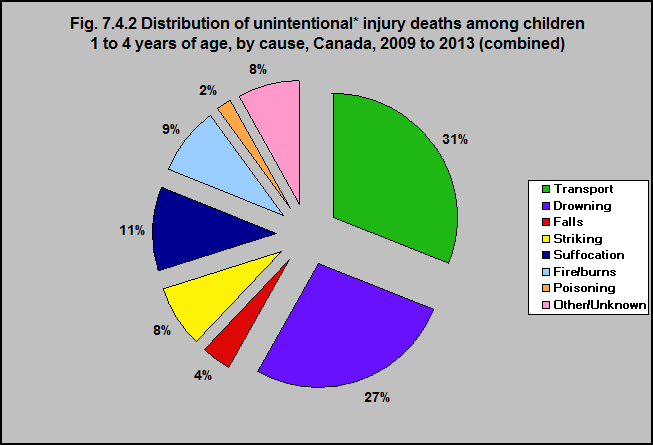Distribution of unintentional injury deaths among children 1 to 4 years of age, by cause, Canada, 2009 to 2013 (combined)

Note:
*Unintentional injuries are unplanned events that occur in a short period of time – seconds or minutes- in which the harmful outcome was not sought and was the result of physical energy in the environment or normal body functions being blocked by external means, e.g., drowning. http://www.maine.gov/dhhs/mecdc/population-health/inj/unintentional.html -accessed June 22, 2017.
Source: CICH graphic created using data adapted from Statistics Canada. Table 102-0540 – Deaths, by cause, Chapter XX: External causes of morbidity and mortality (V01 to Y89), age group and sex, Canada, annual (number). http://www5.statcan.gc.ca/cansim/a26?lang=eng&retrLang=eng&id=1020540&&pattern=&stByVal=1&p1=1&p2=-1&tabMode=dataTable&csid= – accessed June 22, 2017.
In the combined years 2009 to 2013, the most common cause of unintentional injury* deaths among children age 1 to 4 was transport collisions.
In 60% of these transport collisions the children were pedestrians. In 36%, they were an occupant in a car, truck or other vehicle (e.g., ATV).1
The next most common cause of unintentional injury death among 1 to 4 year olds was drowning, followed by suffocation.
1Statistics Canada. Table 102-0540 – Deaths, by cause, Chapter XX: External causes of morbidity and mortality (V01 to Y89), age group and sex, Canada, annual (number). http://www5.statcan.gc.ca/cansim/a26?lang=eng&retrLang=eng&id=1020540&&pattern=&stByVal=1&p1=1&p2=-1&tabMode=dataTable&csid=– accessed June 22, 2017.
Implications
Young children are very vulnerable as pedestrians on the street. Even if children survive a collision as a pedestrian, they are often left with long-term disabilities.1 Experts generally agree that under the age of 9, children may lack the developmental skills to cross the street on their own – therefore they should be supervised.2 In addition, reducing speed limits, teaching children pedestrian safety and making communities more walkable – by making walking routes attractive and safe – are also effective methods to protect young children as pedestrians.1
1Parachute Canada. Halloween Safety Tips. http://www.parachutecanada.org/downloads/resources/WTW_HalloweenSafetyTipSheetFINAL_24OC14.pdf – accessed June 20, 2017.
2Parachute Canada. Pedestrian Safety. http://www.parachutecanada.org/injury-topics/topic/C14 – accessed June 20, 2017.
